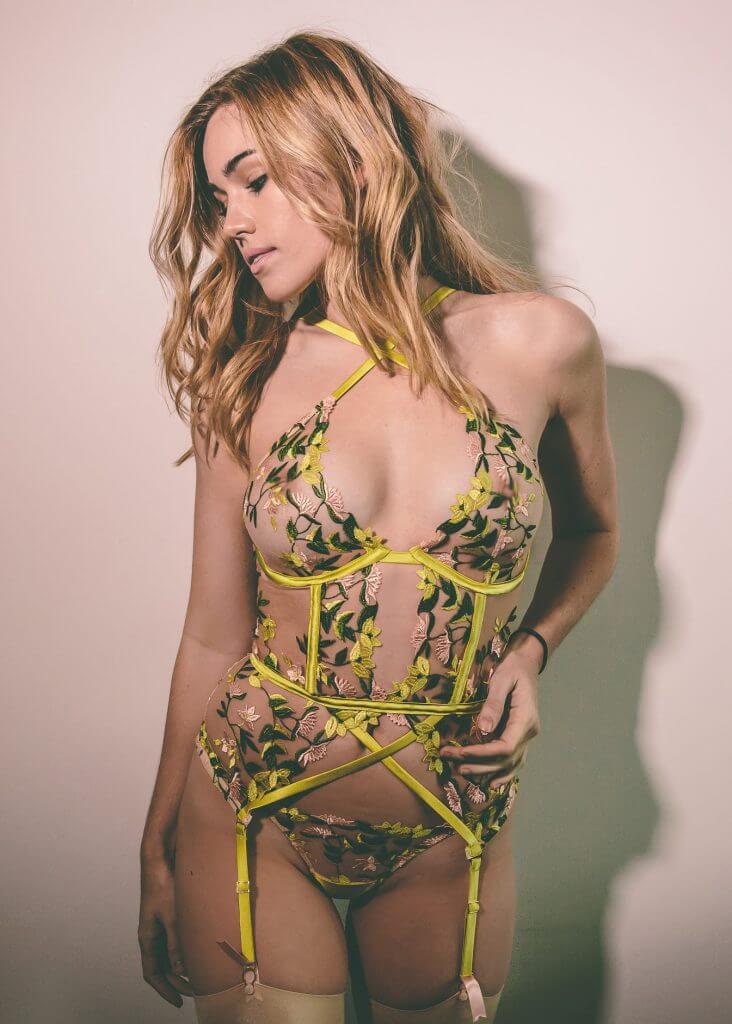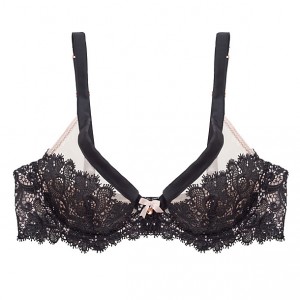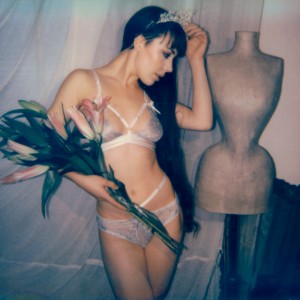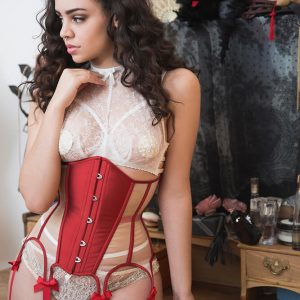Why Don't More Lingerie Brands Custom Design Their Own Lace?
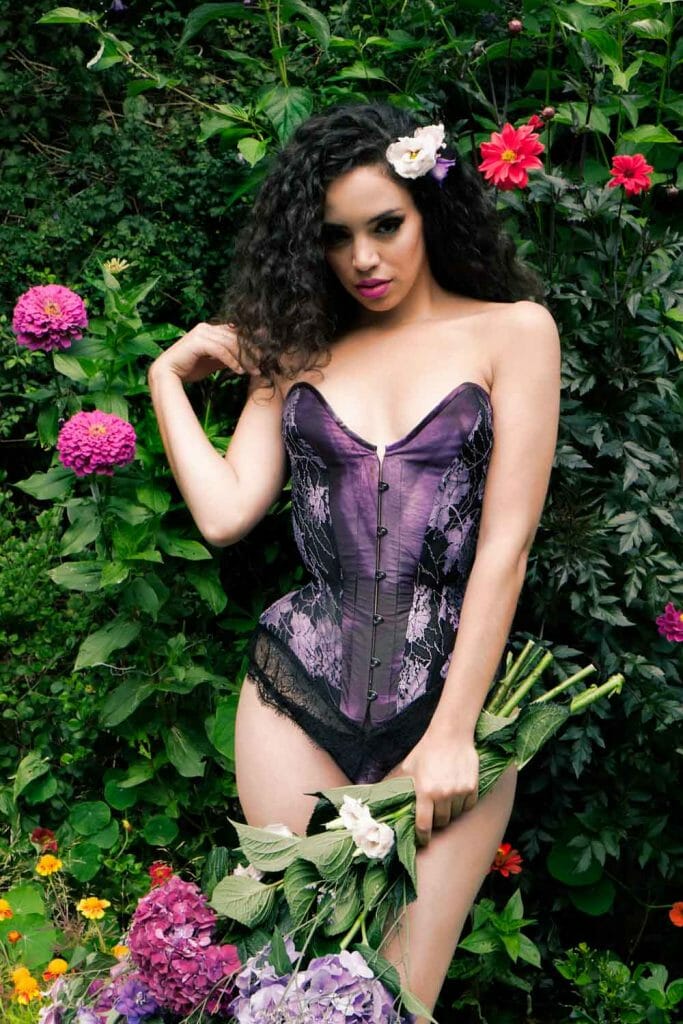
The Leavers lace used in this corset is not a custom design, but was one of the manufacturer's standard designs that was later hand painted. Dyes and embroideries are one of the easiest ways for brands to 'customise' a lace. Design by Karolina Laskowska, photography by Jenni Hampshire, modelled by Yazzmin Newell, MUA by Sammm Agnew.
Recently, someone in the Lingerie Addict Facebook group asked if lingerie brands could design custom lace. I started typing out a response, but quickly realised it’s a very complex question to answer. One about which I have entirely too much to say.
The fashion industry as a whole tends to be quite closed off to customer education, so there isn’t a whole lot of public information about manufacturing or fabrics. I’ve written about lace in lingerie before, but this article goes into a bit more detail on the technical side of lace manufacturing, and how that affects the final lingerie product.
In theory, yes, a brand can absolutely design, commission, and use a custom lace. But that’s purely in theory. While the equipment and human knowledge exists for it to be possible, in practice, the creation would be so incredibly expensive, very few lingerie brands could even consider pursuing it, let alone be profitable.
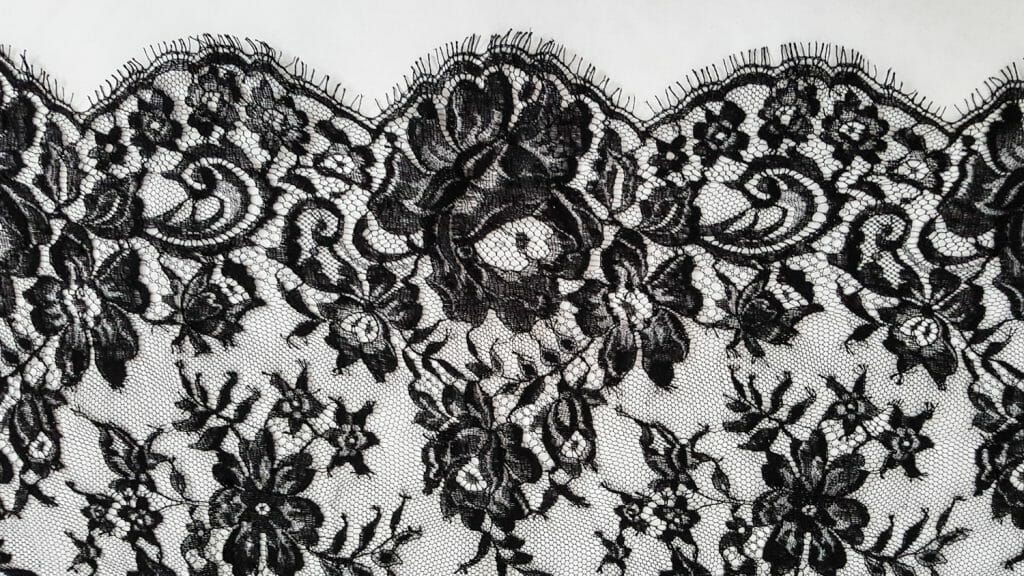
A French Leavers lace. A lace is created by threads being twisted or knitted together.
Photo by Karolina Laskowska
Nevertheless, there are lingerie brands that boast using custom-designed lace. They are indeed using a custom-designed fabric, but there is a lot of confusion around the term ‘lace.’
A true lace is a type of fabric created by twisting or knitting threads together to create patterns. However, the word 'lace' is often used to describe other fabrics, such as embroidery.
Embroidery
Many brands havecustom embroideries made for them. Although still expensive to produce (which is why you mostly see them used only by luxury brands), they are significantly more affordable than custom lace.
An embroidery is a fabric in which a pattern is sewn into an existing fabric, usually with a net tulle base (though a lot of tulles can be made on lace machines, so it’s easy to get confused!).
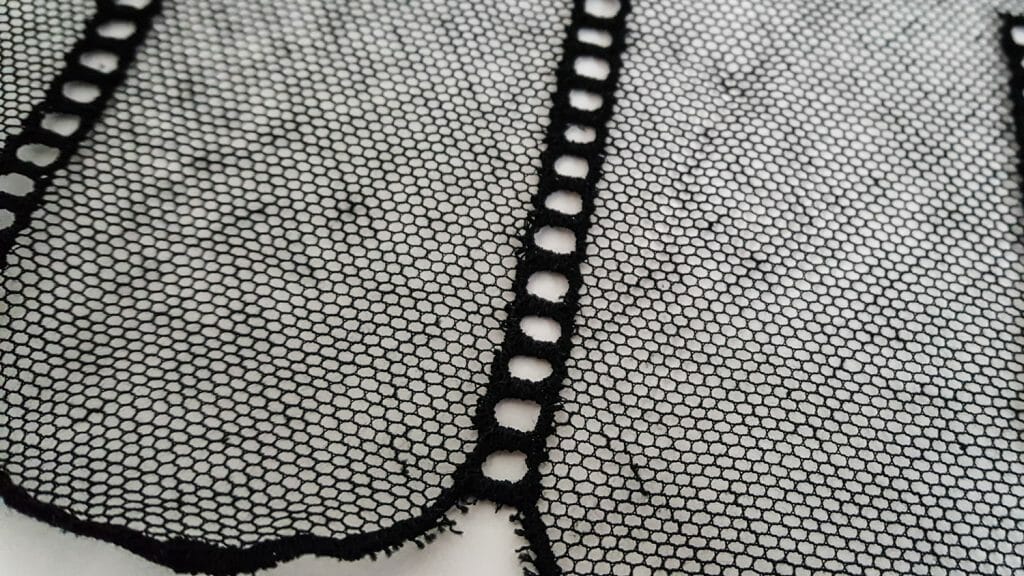
A vintage 1950s embroidered trim up close: the pattern is stitched onto a base of tulle. Photo by Karolina Laskowska
Embroideries are now typically designed on a computer as a digital file, and the sewing machines used for them have their own built-in computers to decipher the files. Incredibly complex designs can be produced by embroidery machines, though the more thread colours and more complicated the pattern, the more expensive and time consuming it can be to produce.
Embroideries can have a similar appearance and ‘feel’ to true lace, especially when they’re stitched onto a very sheer tulle, so it’s not surprising that embroidered tulle is an incredibly popular lingerie fabric. Studio Pia’s ‘Liana’ collection, shown above, uses a custom-designed, multi-toned floral embroidery. The sheer tulle base gives an almost ‘tattoo’-like effect against the skin.
Guipure
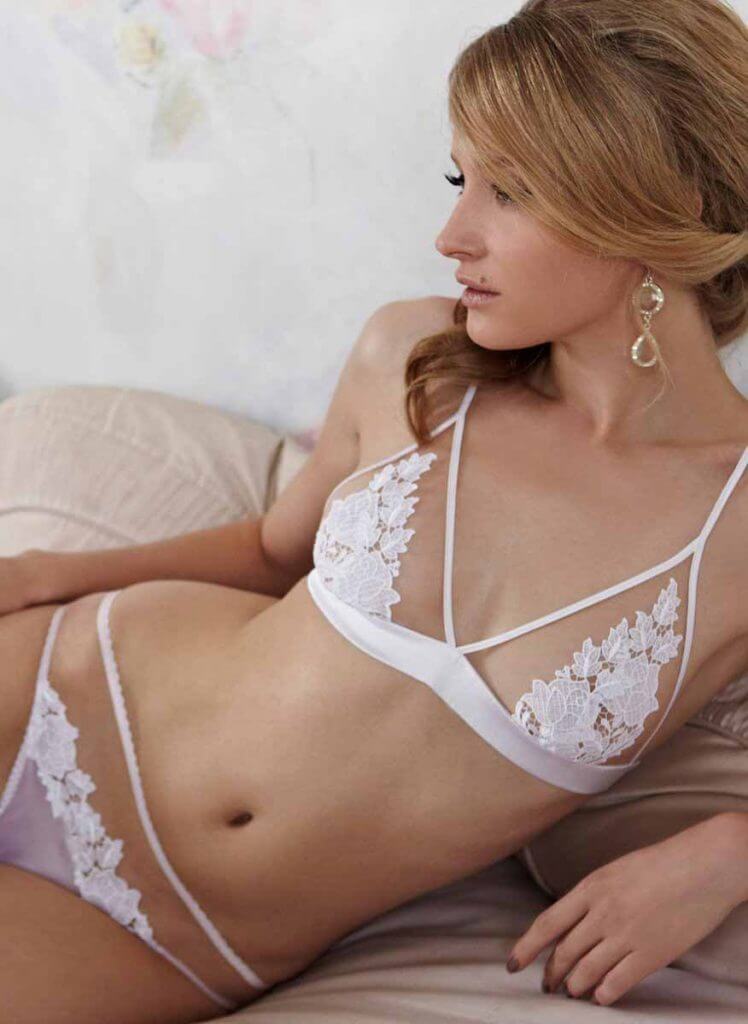
The Fleur of England 'Jasmine' collection uses a custom designed guipure embroidered motif appliquéd onto sheer tulle.
Guipure 'lace' is produced by embroidering a design into a tulle ground that is later dissolved, leaving only the threads of the embroidered design. It’s an effective and striking way to produce a standalone, lace motif, which can also be used as an appliqué.
Like traditional embroideries, guipure is easier and more affordable to have custom made compared to other lace. Although there is more work and expense involved in creating guipure motifs than embroidered fabrics or trims, in comparison, less of that material is used to create a striking design. Fleur of England spearheaded this trend when they used custom-designed guipure motifs on their Jasmine and Belle de Nuit ranges c. 2013.
Raschel Lace
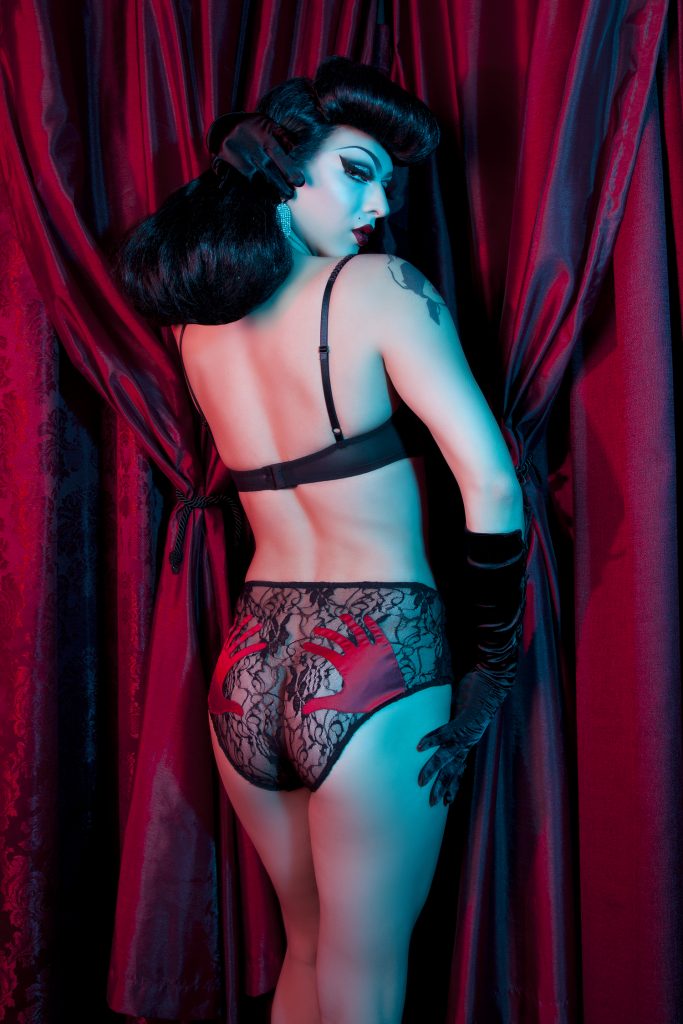
This Bettie Page Lingerie by Playful Promises set uses a raschel lace base, retailing at $58.50 for the full set. A Leavers lace or custom design would make it significantly more expensive!
With guipure and embroidery out of the way, let's discuss the ‘true’ laces traditionally used in lingerie. Raschel lace is the less-costly, mass-manufactured lace typically used in fast fashion. It is machine made with a warp knit, or machine knit. It tends to be cheap because it's made on an industrial scale and there is less variance in design.
Because of those large scales (and thus large order minimums), it’s expensive to have one made just for your brand. The larger the quantities, the lower the cost per unit, so only huge, corporate brands can really afford to get this type of lace made.
A Raschel warp knit machine in action, producing a Raschel lace.
Those are usually the brands making lower-priced, fast fashion, where exclusivity and attention to detail is irrelevant. After all, why go to the expense of custom designing a lace when there are already thousands of existing, ready-made designs for cheaper?
Indeed, a large brand like that might buy all of a particular lace a manufacturer has made in one design to hold exclusivity. Although I’m sure it happens occasionally, designing a custom lace just means less profit in the long run. Raschel lace isn't inherently bad or poor quality; Raschel laces can actually be sturdier than more expensive varieties of the fabric.
Leavers Lace
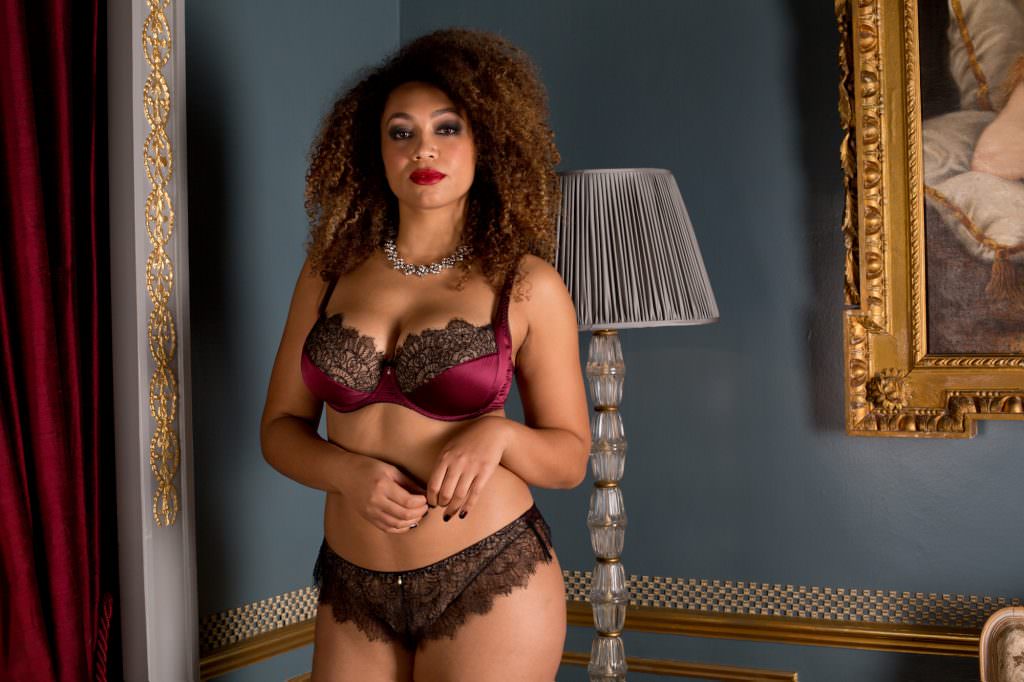
Harlow & Fox's 'Eleanor' range uses a chantilly Leavers lace. The retail price (around $349) reflects the cost of this premium fabric, which is a 'standard' design from the manufacturer rather than custom designed for the brand. You may spot this particular lace used by other fashion designers in different garments.
Leavers lace is arguably one of the finest laces available for modern lingerie making. It’s typically found in higher-end of the market. Leavers lace is one of the earliest kinds of machine-made laces and is still produced today on a machine essentially unchanged from its 19th century specification. It was initially created as a cheaper copy of bobbin lace, a kind of costly, handmade lace.
This video by French Leavers lace manufacturer Sophie Hallette demonstrates some of the immense skill and labour that goes into producing Leavers lace, as well as showing the lace machines in action.
Leavers lace machines produce the fabric by twisting together threads into patterns. Although it’s certainly cheaper than producing those patterns by hand, it’s still relatively expensive because of how much human labour is involved in the process from the set up and maintenance of the machines to the hand finishing of each lace.
The Leavers machine operates on a similar principle to the jacquard loom and uses punch cards to dictate the lace patterns (essentially a kind of very early computer). There are typically hundreds of bobbins of yarn, all of which need to be wound and installed with human hands. It’s common for threads to break in the lace making process, so the machines need constant maintenance.
Once finished on the machine, most laces go through a complex process of hand repair. If the lace has a Chantilly design (wherein there are interrupted patterns amongst a tulle ground), that requires the extra human labour of trimming off the thread jumps around each interrupted design.
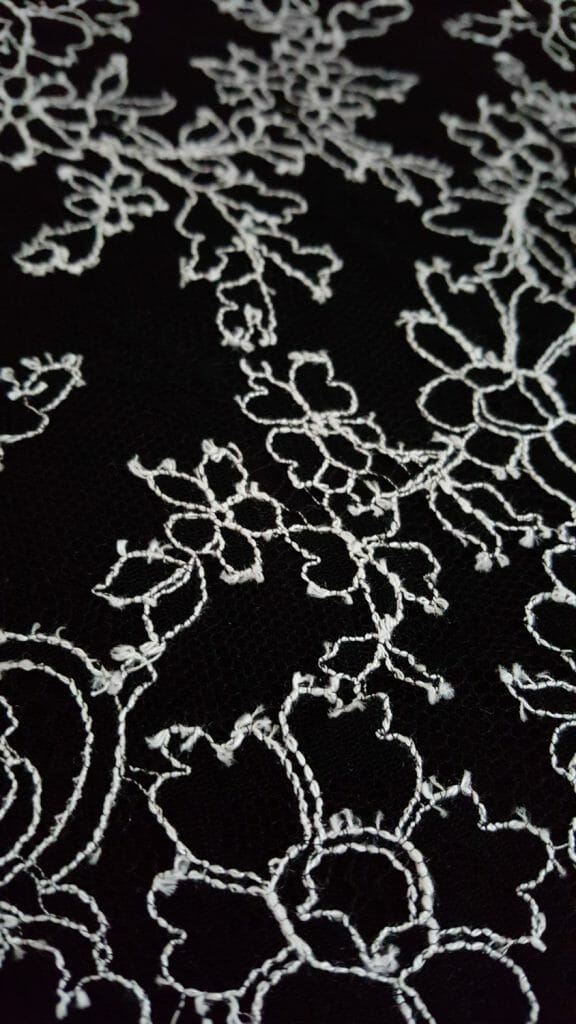
A chantilly lace has an 'interrupted' design in a tulle base. The threads at the end of each interruption have to be trimmed off by hand, leaving little tufts of thread around the motifs. Photo by Karolina Laskowska
Long story short, Leavers lace is very expensive to produce, mostly because it requires a lot of human labour. Designing a custom lace pattern is technically possible (as long as it can be transferred to the punch card system), and most of the Leavers lace houses are continually designing new lace patterns themselves to release to their fashion industry customers.
Novelty drives fashion in every sector, and although most lace houses have huge archives of designs (after all, some houses have existed for over 200 years), creating new designs helps to keep them relevant. Custom designs will be reserved for the highest price point of fashion because even the ‘standard’ designs and colours from manufacturers can be incredibly costly. For reference, the minimum orders on certain lace trims of existing designs can start at five figures! For independent lingerie brands, those prices throw the option of custom design far out of the window.
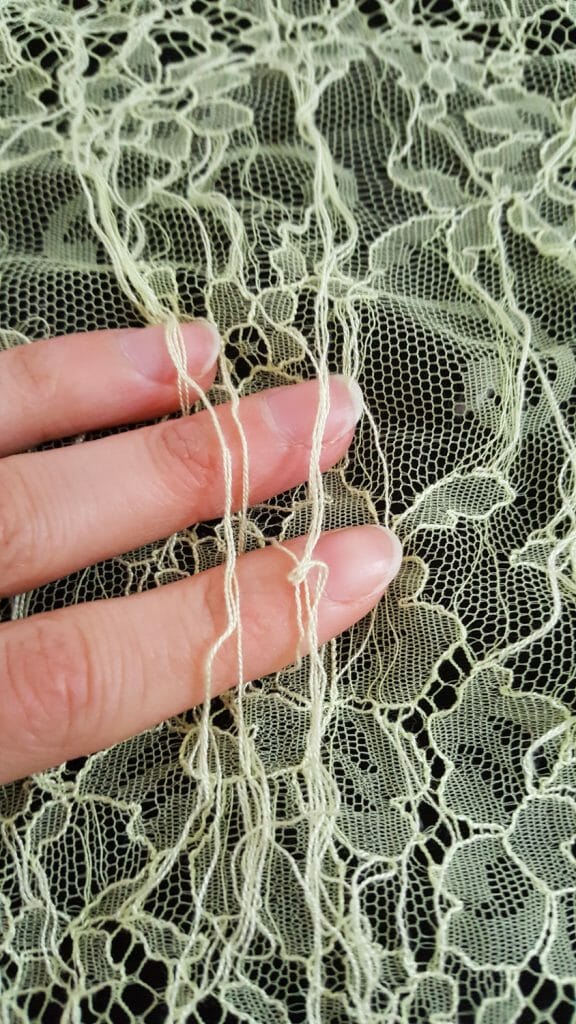
A chantilly lace is characterised by an interrupted pattern through a tulle base. Each 'interruption' in the pattern causes the outline threads to 'skip', which then have to be trimmed off by hand. This is an incredibly time consuming process that requires skill and accuracy. Photo by Karolina Laskowska
Embellished Lace
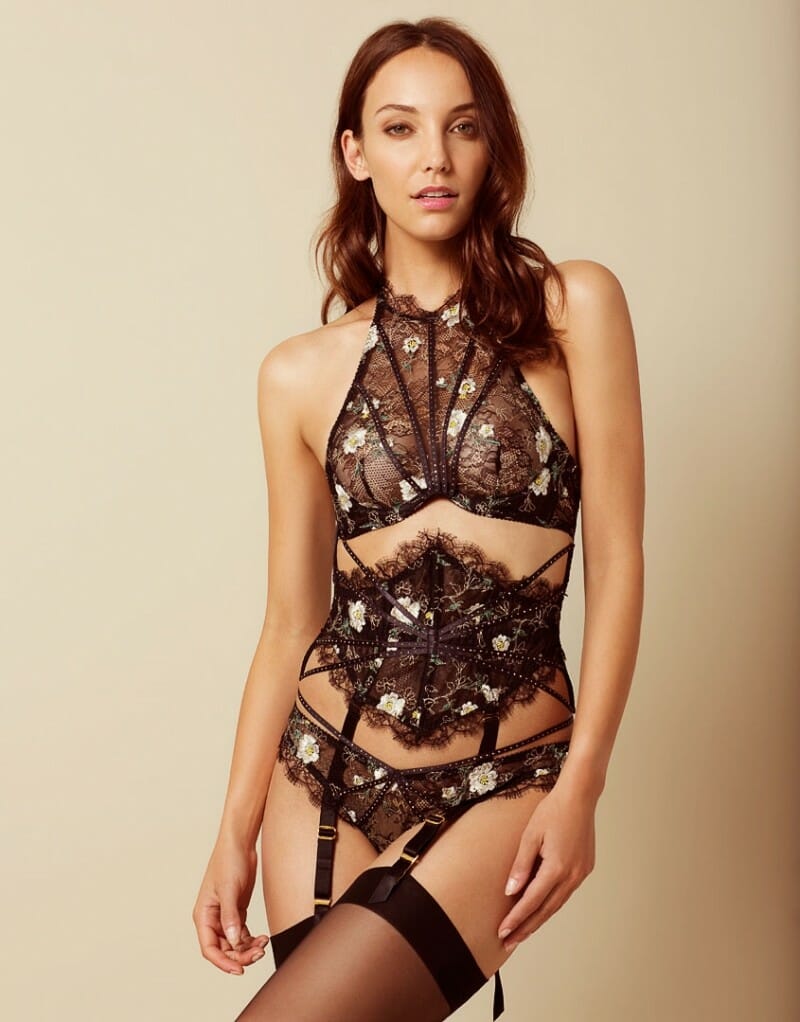
The Athena range by Agent Provocateur uses a Leavers lace base that's machine re-embroidered with a daisy motif.
Brands do have a few options to hand for ‘customising’ existing laces, even if a 100% exclusive design is off the table. Existing laces can be re-embroidered, whether by machine or hand (usually this is referred to as a ‘Rebrodée’ lace; the industry does have a tendency to use French words just to make things sound fancier!).
The embroidered designs can be used to add texture to an existing lace pattern, and even to add beads. It’s still a fantastically expensive fabric because it requires an expensive base material, but it's alsocheaper than designing something from scratch. Agent Provocateur used a rebrodée lace for its ‘Athena’ range, machine embroidering daisies onto an existing Leavers lace. It’s not surprising it’s part of their ‘premium’ collection, with the bra along costing £495 (around $680).
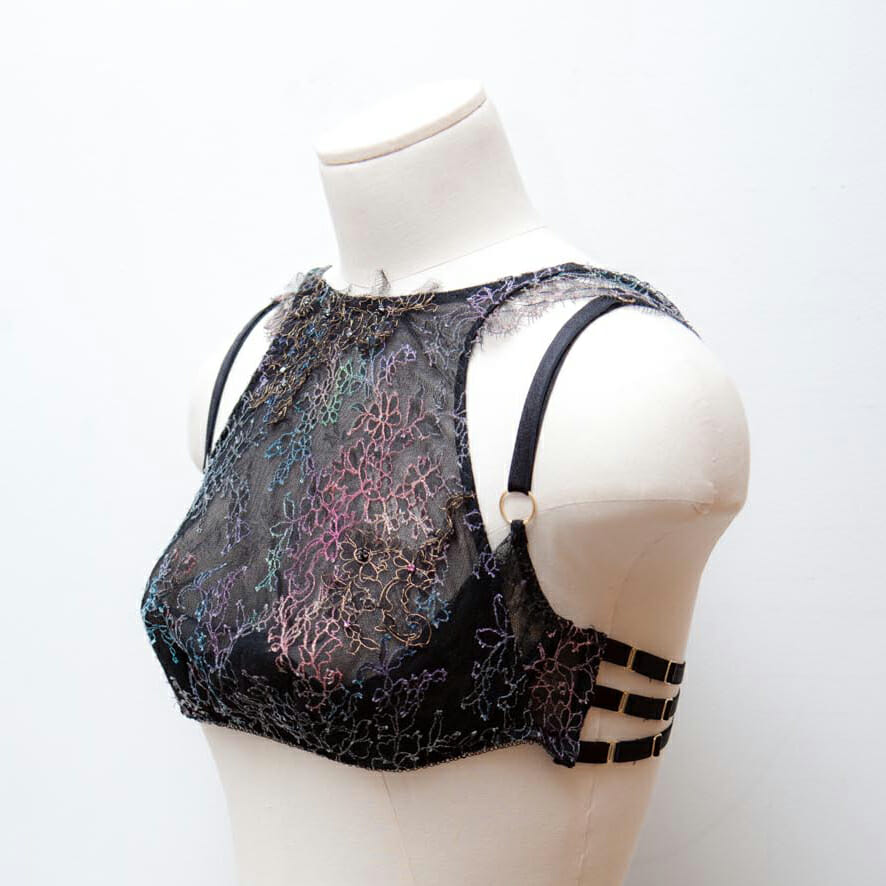
The lace for this bra was painted by hand and then re-embroidered with further lace appliqué and Swarovski crystal beading. It's a one-of-a-kind piece with many hours of hand work.
This sort of textile customisation is only really available at the made-to-order, luxury end of the lingerie market. It would be unfeasibly expensive to recreate for a production run. Design by Karolina Laskowska
Existing laces designs can also be custom dyed, whether by the lace mill or a specialist dye plant. Even if it’s a standard floral patterned lace, designers can play with techniques such as dip dyeing, tie-dyeing, or just use an allover custom colour. Again, these aren’t cheap techniques and most likely would only be seen in high end lingerie design, but it’s more accessible than other options.
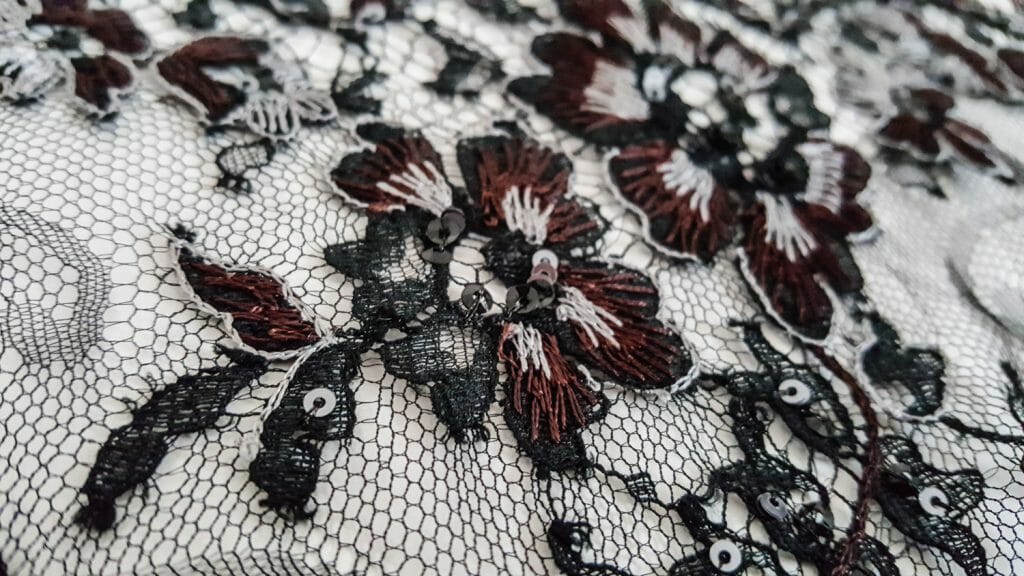
A rebrodée lace up close. The base lace is made of plain black twisted threads, and is later embellished with sewn on colourful threads and beads. Photo by Karolina Laskowska
Handmade Lace
That leaves one final option for custom lace: handmade lace. The option of handmade lace is completely off the table for most brands, especially if they have production runs, due to a combination of time and expense.
Handmade lace (whether it be bobbin, needle, tatted et al.), requires a great deal of skill, patience, and time to produce. It can take hours to produce only a small length and takes quite a lot of experience for complex designs. The only reasonable use I can see for a small, independent designer learning the skill themselves is purely for a one-off, showpiece garment. Anything further than that would be unfeasibly costly.
Final Thoughts
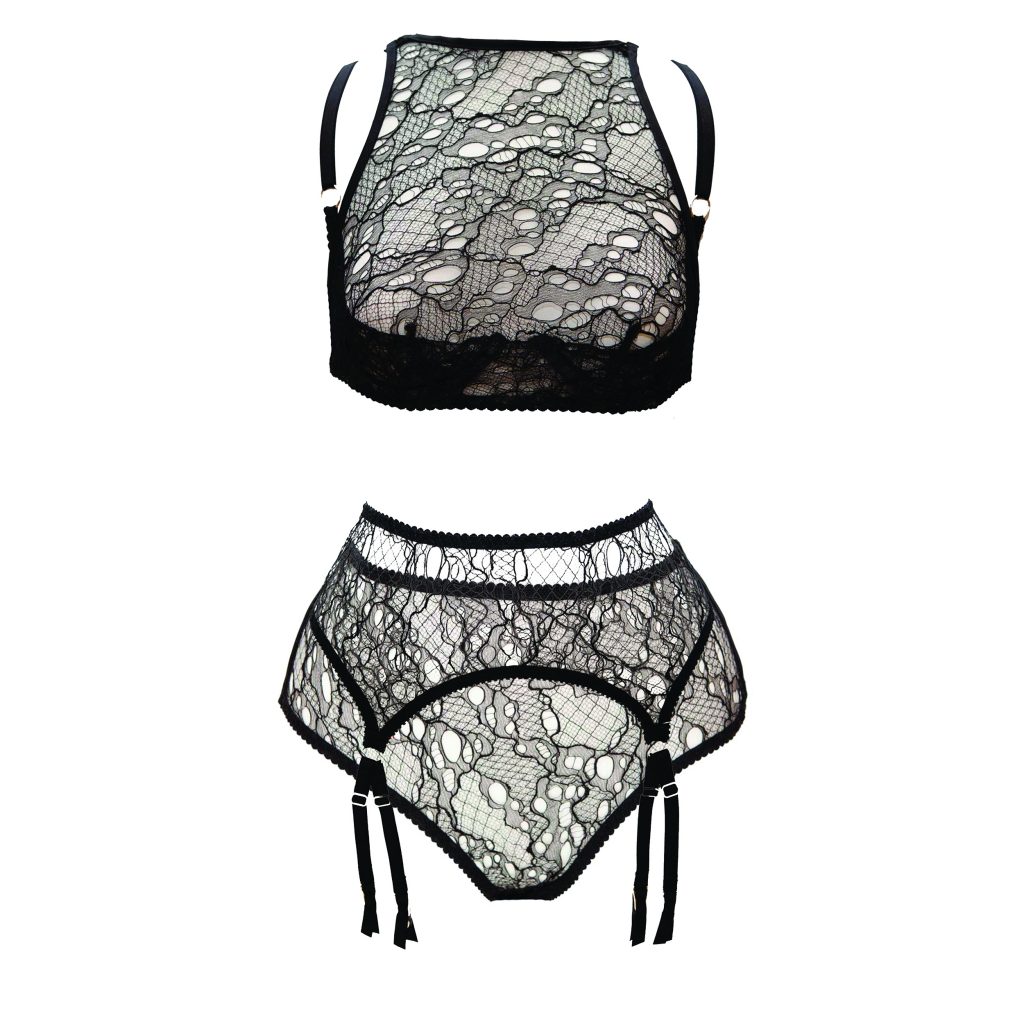
Lace doesn't have to be limited to floral designs. There are more options than ever before, including graphic and organic patterns. The Debjani lingerie set by Karolina Laskowska uses an abstract patterned Leavers lace with cording detail.
There’s a chasm between what is technically possible and what is plausible in the world of fashion. Everything comes down to money. Even for the most luxurious brands, cost and profit have to be heavily considered, which for many means even the idea of a customised lace is off the table.
Fortunately, there’s already a wealth of beautiful lace designs in existence. Whether you’re a fan of traditional florals, organic abstract patterns, or something graphic, there will be something to suit your tastes somewhere. After all, there's more choice in the fashion industry than ever before, even if designers have to face some limitations.





